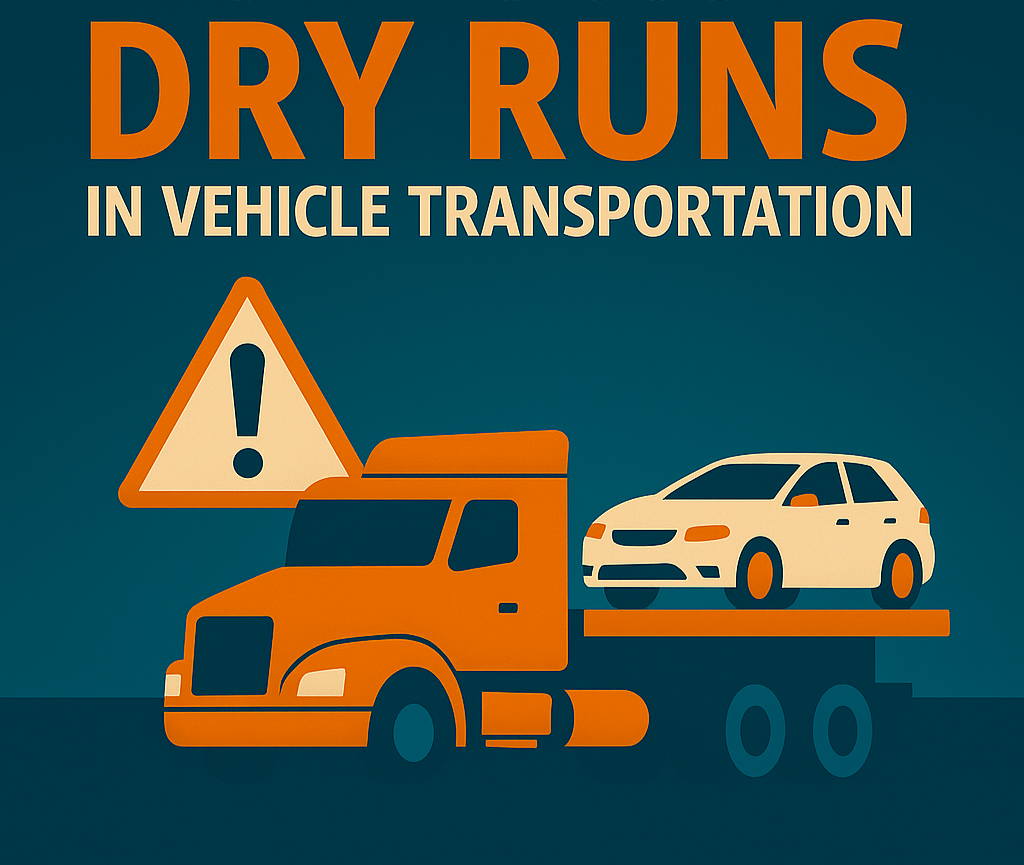Avoiding Costly Dry Runs in Vehicle Transportation: What You Must Know
In the fast-moving world of logistics and transportation, miscommunication can cost you — sometimes literally. One such example is the all-too-common “dry run” in vehicle pickups, a headache many dispatchers and coordinators know too well.
But what exactly is a dry run? Why does it happen? And how can we prevent it?
❓ What’s a “Dry Run” in Transportation?
A dry run refers to a failed vehicle pickup — where the carrier shows up, but the unit isn’t ready, isn’t there, or something vital has changed.
And while it may sound harmless, it’s anything but.
Carriers often charge a dry run fee (typically ranging from $75 to $250 or more) to compensate for the wasted trip, fuel, driver time, and scheduling disruption. For companies handling multiple pickups weekly, the cost adds up fast.
📍 Common Scenarios That Cause Dry Runs
Let’s take the vehicle transport sector as a case study. Whether you’re picking up from a dealership, auction house, or even a private seller, dry runs can occur due to:
- Vehicle Still in PSI (Post-Sale Inspection)
Even if the customer confirms readiness, the car may be undergoing a post-sale check or reconditioning. - Mechanical Issues or Safety Recalls
The unit may be parked but flagged for repairs or outstanding recalls that must be addressed before release. - Uncleared Payment
Payment hasn’t cleared yet. Some auctions or dealerships won’t release the unit until funds are fully processed. - Incorrect or Changed Pickup Location
Dispatch is given one address, but the unit was relocated — and nobody communicated the change. - Lack of Pickup Authorization
Driver arrives but isn’t on the authorized release list, or doesn’t have proper ID or paperwork.
🛑 The Cost of Assumptions
In one real-world example, a dispatcher assumed the unit was ready based on emailed documents. The carrier was sent. On arrival? The dealership staff refused release. The unit was still undergoing emissions testing.
Result: A $150 dry run fee, a reschedule delay, and an unhappy customer.
✅ How to Prevent Dry Runs: Simple but Effective Steps
To avoid dry runs and protect both your budget and brand, logistics professionals must shift from assumption to verification:
🔹 1. Direct Communication
Call the dealership or auction directly, not just the customer. Confirm:
- Vehicle readiness
- Pickup address
- Any special conditions (e.g., release documents, hours of operation)
🔹 2. Log Confirmation
Document the name, date, and details of the person you spoke to. This adds accountability and helps resolve disputes later.
🔹 3. Update the Carrier
Share the confirmed details with your driver or carrier, including:
- Lot number
- VIN
- Contact person onsite
- Any changes that occurred last-minute
🔹 4. Keep the Customer Informed
Let the customer know the outcome of your checks. If there’s a delay or open issue, they’ll appreciate your transparency.
🎯 Why It Matters
In a business where time is money, every avoidable delay is a risk to profit and reputation. Dry runs frustrate everyone:
- Carriers lose time
- Dispatchers juggle rebookings
- Clients lose trust
And the worst part? Most dry runs are 100% preventable.
🎧 Want More Field-Based Logistics Lessons?
This is the kind of insight we unpack on the Tales of Logistics Podcast — real challenges, practical fixes, and lessons from the frontline of transport, warehousing, and customs.
Visit TalesOfLogistics.com to read more articles like this, explore tools, or listen to our latest podcast episodes on:
- Border delays
- Customs compliance
- Dispatching best practices
- Logistics tech & trends
Because in logistics, clarity isn’t a luxury — it’s a necessity.
